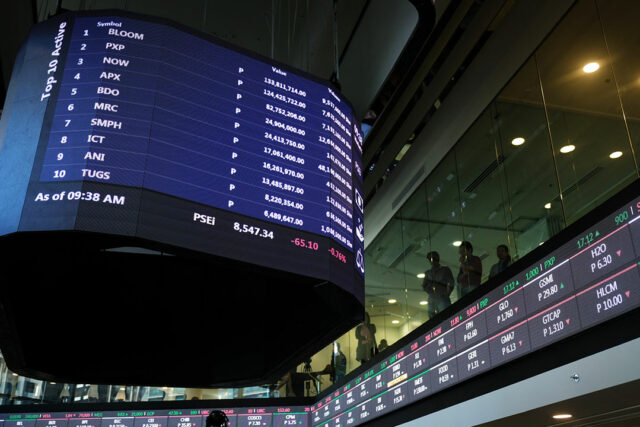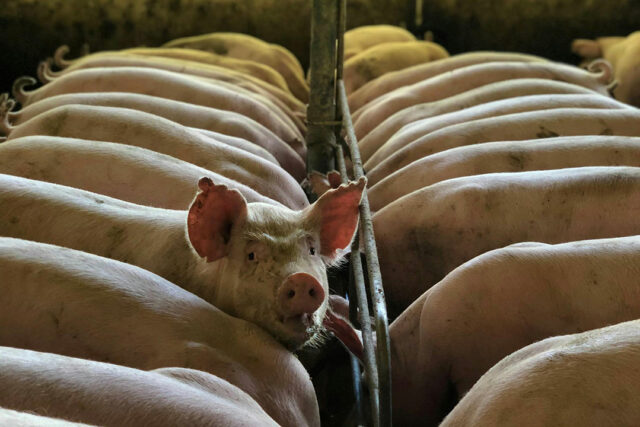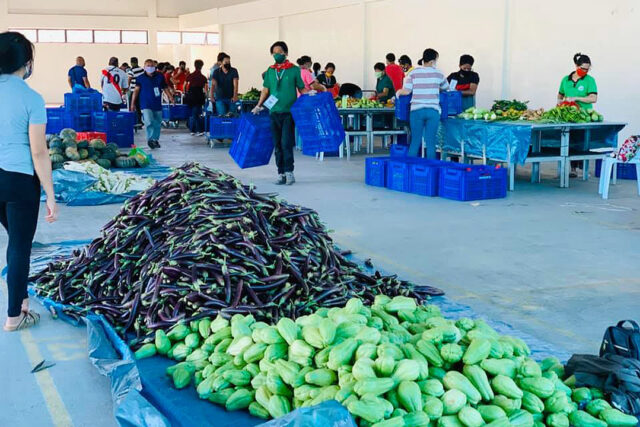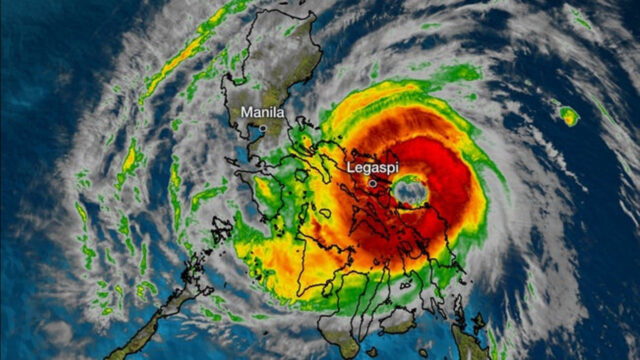Stocks rebound on hopes of September Fed cut
PHILIPPINE STOCKS rebounded to hit a fresh four-month high on Thursday on growing expectations of a rate cut by the US Federal Reserve next month.
The bellwether Philippine Stock Exchange index (PSEi) rose by 0.88% or 61.34 points to end at 6,961.96 on Thursday, while the broader all shares index went up by 0.68% or 25.35 points to close at 3,749.73.
Thursday’s close was the PSEi’s best finish in more than four months or since it ended at 6,979.81 on April 1.
“The local market bounced back this Thursday… Investors took cues from Wall Street’s rally overnight driven by the Federal Reserve’s July meeting minutes, which hinted at possible rate cuts by September,” Philstocks Financial, Inc. Senior Research Analyst Japhet Louis O. Tantiangco said in a Viber message.
“Most Fed officials signaled that easing monetary policy would be appropriate if economic data meets expectations, raising hopes for lower interest rates soon. All eyes are now on Fed Chair Jerome H. Powell, who is set to speak at the Jackson Hole Economic Symposium on Friday, potentially offering further guidance on the Fed’s next steps,” Regina Capital Development Corp. Head of Sales Luis A. Limlingan said in a Viber message.
The Fed appears to be very much on track for an interest rate cut in September after a “vast majority” of officials said such an action was likely, according to the minutes of the US central bank’s July 30-31 meeting, Reuters reported.
The minutes, which were released on Wednesday, even showed some policymakers would have been willing to reduce borrowing costs at last month’s gathering.
The policy-setting Federal Open Market Committee left its benchmark interest rate unchanged in the 5.25%-5.5% range on July 31, but opened the door to a cut at the Sept. 17-18 meeting.
Financial markets have been expecting the September meeting to kick off the Fed’s policy easing, with as much as a full percentage point worth of rate cuts expected by the end of this year.
Majority of sectoral indices closed higher. Financials rose by 2.52% or 52.17 points to 2,122.39; holding firms increased by 0.72% or 42.58 points to 5,883.84; services climbed by 0.71% or 15.92 points to 2,238.06; and industrials went up by 0.32% or 29.97 points to 9,237.94.
On the other hand, property declined by 0.67% or 18.30 points to 2,704.59; and mining and oil dropped by 0.06% or 5.17 points to 8,155.97.
Value turnover rose to P6.99 billion on Thursday with 653.22 million shares changing hands from the P5.14 billion with 863.73 million stocks traded on Wednesday.
Advancers beat decliners, 117 versus 80, while 43 names were unchanged.
Net foreign buying rose to P2.34 billion on Thursday from P565.27 million on Wednesday.
Philippine financial markets will be closed on Friday (Aug. 23) for a special nonworking holiday in observance of Ninoy Aquino Day, which was moved from the original Aug. 21 date. — R.M.D. Ochave with Reuters
Peso rises to new 4-month high as Fed minutes bolster cut bets
THE PESO appreciated to another over four-month high against the dollar on Thursday as minutes of the US Federal Reserve’s July policy meeting cemented market expectations of a September rate cut in the world’s largest economy.
The local unit closed at P56.333 per dollar on Thursday, strengthening by 16.7 centavos from its P56.50 finish on Wednesday, Bankers Association of the Philippines data showed.
This was the peso’s best finish in more than four months or since its P56.315-a-dollar close on April 2.
The peso opened Thursday’s session at P56.333 against the dollar, which was also its closing level. It traded stronger than its Wednesday close the entire session as its weakest showing was at just P56.38, while its intraday best was at P56.28 versus the greenback.
Dollars traded inched up to $1.589 billion on Thursday from $1.588 billion on Wednesday.
The peso strengthened on the back of the dovish tone of the minutes of the Federal Open Market Committee’s (FOMC) July meeting, a trader said in a phone interview.
“The market still traded mostly sideways a while ago since they are awaiting the Jackson Hole Symposium,” the trader added.
“The peso followed most major Asian currencies up versus the dollar. There was selling interest for the pair as the dollar weakened after the FOMC minutes showed more support for rate cuts,” Security Bank Corp. Chief Economist Robert Dan J. Roces said in a Viber message. “Any dovish tilt post-Jackson Hole Symposium should also weigh on the dollar further and strengthen the peso.
Philippine financial markets will be closed on Friday (Aug. 23) for a special nonworking holiday in observance of Ninoy Aquino Day, which was moved from the original Aug. 21 date.
The Federal Reserve appears to be very much on track for an interest rate cut in September after a “vast majority” of officials said such an action was likely, according to the minutes of the US central bank’s July 30-31 meeting, Reuters reported.
The minutes, which were released on Wednesday, even showed some policy makers would have been willing to reduce borrowing costs at last month’s gathering.
The policy-setting Federal Open Market Committee left its benchmark interest rate unchanged in the 5.25%-5.5% range on July 31, but opened the door to a cut at the Sept. 17-18 meeting.
Financial markets have been expecting the September meeting to kick off the Fed’s policy easing, with as much as a full percentage point worth of rate cuts expected by the end of this year.
At the July meeting, most policy makers thought that “if the data continued to come in about as expected, it would likely be appropriate to ease policy at the next meeting,” the minutes said.
They also noted “many” Fed officials viewed the stance of rates to be restrictive and “a few participants” contended that amid an ongoing cooling in inflationary pressures, no change in rates would mean that monetary policy would increase the drag on economic activity.
While all Fed officials were on board with keeping rates steady in July, the minutes revealed that “several” policy makers said progress in lowering inflation amid a rise in joblessness “had provided a plausible case” for a quarter-percentage-point cut in July, “or that they could have supported such a decision” had it been on the table.
The minutes also showed that a dwindling camp of policy makers feared a premature easing in monetary policy could restart inflation.
With the Fed letting the data determine what happens with rates, central bank watchers are already contemplating the future scope of cuts and whether aggressive action is needed at the onset of the easing cycle.
Fed Chair Jerome H. Powell largely tipped off the likely outlook after the July policy meeting when he said “if we do get the data that we… hope we get, then a reduction in our policy rate could be on the table at the September meeting.”
Markets are likely to get an update of Mr. Powell’s views on Friday when he speaks at the Kansas City Fed’s annual research conference in Jackson Hole, Wyoming. A number of other Fed officials are also likely to weigh in on the outlook while attending the conference. — A.M.C. Sy with Reuters
ASF vaccine subsidy studied for small-scale hog farmers
THE Department of Agriculture (DA) said that it is considering a subsidy for African Swine Fever (ASF) vaccines to be distributed to backyard hog farmers.
“We have talked about this in the DA. This would depend on the availability of our funds… we are already spending a lot, especially on hog repopulation,” Agriculture Assistant Secretary for Poultry and Swine Constance J. Palabrica told reporters on Thursday.
Hog farmers have been batting for a more affordable ASF vaccine to minimize the impact on production costs, which could flow on to consumer prices.
The government has yet to release an official price for the ASF vaccine from Vietnam, pending the approval of a commercial rollout.
“It could be subsidized depending on the study of the DA. It would be for backyard (hog farmers) because they cannot afford it. The large farms will not be subsidized,” Mr. Palabrica added.
The DA has allocated P350 million to procure 600,000 doses of ASF vaccine for limited release in test conditions during the quarter.
He said that five other companies have expressed interest in applying for vaccine certification from the Food and Drug Administration.
He said the companies are from the US, Vietnam, South Korea, and Thailand.
“They have a process to go through because we cannot approve it until we go through (it)… and prove that they could be effective,” Mr. Palabrica said.
Additionally, the Bureau of Animal Industry (BAI) said it will need to collect blood samples before injecting the vaccine, which can be used only on healthy animals.
“Only healthy pigs will be vaccinated to prevent the spread of the virus and minimize possible virus mutation,” the BAI said in a statement.
It added that local government units will be tasked with validating that biosecurity measures at hog farmers meet government standards before the vaccine is administered. — Adrian H. Halili
Clark food hub bill clears House panel
A HOUSE of Representatives committee approved a bill on Tuesday seeking to establish a national food hub at the Clark airport complex in Central Luzon, which is intended to streamline the food logistics system.
The House trade and industry committee endorsed House Bill No. 10678, which proposes to set up a food hub within the Clark Freeport Zone.
“Establishing a national food hub in Clark will play a crucial role in shortening the supply chain from producer to consumer,” Cagayan de Oro Rep. Rufus B. Rodriguez said in a statement on Thursday.
“(It) will not only standardize logistics but also ensure the efficient movement of food products, thereby enhancing overall efficiency,” he added.
The 62-hectare Clark food hub will contain state-of-the-art food warehouses, cold storage facilities, and wholesale and retail market space.
The first phase of the P8.5-billion food hub project is expected to be completed by the end of 2027, Clark International Airport Corp. (CIAC) President Arrey A. Perez said in July.
The CIAC, which operates the 2,300-hectare Clark aviation complex, will also operate the food hub.
“As soon as this proposal becomes a law, it will bolster agro-logistics as support to our country’s robust agricultural production,” Mr. Perez said in the same statement.
“It will also enhance freight transport services, mobility, and access to key economic zones, toward seamless logistics and efficient supply chains,” he added.
The food hub will also help develop the so-called Luzon Economic Corridor, Mr. Perez said, noting the project will help better position the Philippines as a “regional hub for agribusiness and logistics in Asia-Pacific.”
The approval of the bill at committee level is a step towards improving food logistics, Special Assistant to the President for Investment and Economic Affairs Frederick D. Go said in the same statement.
“We continue to pursue initiatives that contribute to increasing agriculture production, and improving the food logistical chain,” he said. “The Clark National Food Hub is a step in this direction, and we look forward to its successful establishment as a sustainable food security solution.”
The bill will be debated next by the House appropriations and ways and means committees for the measure’s funding and tax incentive provisions. — Kenneth Christiane L. Basilio
Effort to attract technology investments hindered by red tape, energy issues
BUREAUCRACY and issues with energy remain the top challenges in attracting technology investment from China, according to the Federation of Filipino-Chinese Chambers of Commerce and Industry (FFCCCII).
“In the Philippines, investors need to go through individual departments, and by the time they finish, it has already taken years,” FFCCCII President Cecilio K. Pedro said at a forum on Wednesday.
He said in other countries, the equivalent process typically has one point of contact.
“They do everything to accommodate investors to make it simple; they simplify rules so that they can come in and invest,” he added.
He said that the Philippines needs to attract manufacturing companies from China.
“We need companies like Apple to come in, but… they went to Vietnam… So there must be something good in Vietnam that we don’t have,” he added.
During the Manila Forum for Philippines-China Relations, Chinese Ambassador Huang Xilian said that he hopes the Philippines can replicate the Guangdong-Hong Kong-Macau Greater Bay Area concept in the cities and provinces around Manila Bay.
“Led by the ambitious goal of Chinese modernization, a more vibrant Greater Bay Area is to be expected. It is the closest neighbor to the Philippines, with only about 1,000 kilometers or a two-hour flight from Manila Bay,” Mr. Huang said.
“Manila Bay, we hope, will be the Manila Greater Bay Area in the future. We warmly welcome our friends from the Philippines to the Greater Bay Area, to explore and experience it for yourselves,” he added.
The Greater Bay Area is built around economic centers in the Pearl River Delta in Guangdong Province, including the former European colonies Hong Kong and Macau as well as the manufacturing powerhouse of Shenzhen.
According to Mr. Pedro, the ambassador “sees the potential” in linking Bataan and Cavite more closely with greater Manila and Bulacan.”
He said a Greater Bay Area-style integrated economic region in the Philippines has the potential to attract more investment.
The Greater Bay Area in China has a $1.98-trillion gross domestic product, making it among the fastest-growing regions in China.
Evariste M. Cagatan, executive director for the Board of Invesments’ Investment Promotions Services arm, described a Greater Bay Area in the Philippines as feasible even with the Luzon Economic Corridor in the pipeline.
“The areas that were mentioned, which can be potentially part of that — Manila, Bulacan, Bataan, and Cavite — are also the high-growth areas of the country. So, I think this is possible,” Ms. Cagatan said. — Justine Irish D. Tabile
PPA awards contract to draft master plan for selected ports
THE Philippine Ports Authority (PPA) has awarded a P32-million contract to develop a master plan for selected ports to help improve cargo operations in support of agro-industrial development.
In a notice of award, PPA said the joint venture of Science and Vision for Technology, Inc. and Syconsult, Inc. was awarded the contract to prepare feasibility studies and draft a master plan for the selected ports.
“The ports master plan study is initiated per port before we start constructing and implementing,” PPA General Manager Jay Daniel R. Santiago said via Viber on Thursday.
The master plan aims to determine and assess the feasibility of constructing ports at designated locations, Mr. Santiago said, adding that the study also seeks to upgrade the ports to meet the needs of agro-industrial development.
The study is due one year after the winning bidder receives the notice to proceed, PPA said.
The PPA has identified the ports as Davila, Pasuquin, Ilocos Norte; Puerto Galera, Oriental Mindoro; Taytay, Palawan; Buenavista, Guimaras; San Carlos, Negros Occidental; Dumaguete, Negros Oriental; Lazi, Siquijor; Catbalogan, Samar; Zamboanga; and Cagdianao, Dinagat Islands.
The PPA reported that only two of the five consulting firms submitted bids to prepare the feasibility study and master plan for the 10 ports. — Ashley Erika O. Jose
Small Business Corp. offering new loan products — Trade dep’t
THE Department of Trade and Industry (DTI) said the Small Business Corp. (SBC) will tap a P10-billion fund in offering new loan products directed at micro, small and medium enterprises (MSMEs).
The loan products include purchase order financing, check discounting, factoring, and franchise financing, the DTI said.
At the Metro Manila Business Conference on Thursday, Acting Trade Secretary and SBC Chairman Cristina Aldeguer-Roque said MSMEs, despite being the backbone of the Philippine economy, still face financing challenges.
“Access to finance, limited market reach, and the adoption of new technologies are just a few of the hurdles that they must overcome,” Ms. Aldeguer-Roque said.
“Thus, the DTI is committed to addressing these challenges head-on and creating an enabling environment where MSMEs can flourish,” she added.
She said the loan products will be offered in collaboration with Banco de Oro, Union Bank, and the Bank of the Philippine Islands.
“Now there’s P10 billion for the MSMEs to be loaned, but there’s actually more funding that will be coming in,” she added.
“The new loan products are all available now in SBC, so we encourage the MSMEs to use them because the interest on the loans is very low,” she said.
“We also just approved the P200-million startup fund for MSMEs,” she added.
The DTI also aims to streamline the loan application process for MSMEs, she said.
“It used to take months for the application to be processed; now it’s 19 days, but I am lowering it by one week,” she said.
One of the goals of the DTI through SBC is to boost manufacturing, which is considered to have the potential to generate the most jobs.
“We need to strengthen the manufacturing industry in the Philippines because once it’s strengthened, it will create a lot of jobs,” she said. — Justine Irish D. Tabile
Budget dep’t approves P3.68-B release for free Wi-Fi project
AN ADDITIONAL P3.68 billion will be released to help build digital infrastructure to support the free Wi-Fi program, according to the Department of Budget and Management (DBM).
This is on top of the P2.5 billion earmarked under the Free Public Internet Access Program expected to be fully obligated this month, the DBM said in a statement.
The funds will help build and maintain towers and data centers to improve internet access in schools, libraries, parks, and transportation hubs. The government hopes to build 13,462 Access Points nationwide, according to the DBM.
“We understand that our countrymen need this. With the budget released, we are hopeful that the DICT (Department of Information and Communications Technology) can proceed swiftly with the fund disbursement and expedite the program’s implementation,” Budget Secretary Amenah F. Pangandaman was quoted as saying.
The allocation is chargeable against the Special Account in the General Fund – Free Public Internet Access Fund in this year’s P5.768-trillion national budget.
“By approving this additional budget within our calibrated fiscal program, we reaffirm our commitment to prioritizing inclusive and accessible internet for all,” she added.
A 2022 report by the World Bank showed that only 33% of Philippine households have access to fixed broadband, while 70% of the population have an active mobile broadband subscription.
Broadband internet remains costlier in the Philippines than in neighboring countries, with the annual charge for fixed broadband equivalent to 11% of per capita gross national income.
This represents twice as much as the ASEAN (Association of Southeast Asian Nations) average, the World Bank said.
In June, the National Economic and Development Authority Board headed by President Ferdinand R. Marcos, Jr. approved the P16.1-billion Philippine Digital Infrastructure Project, which also seeks to bring faster internet in disadvantaged locations. — Beatriz Marie D. Cruz
Disaster risk financing for PHL to hinge on closer collaboration within region
THE Department of Environment and Natural Resources said on Thursday that it is seeking closer collaboration with regional partners to improve the Philippines’ access to disaster risk financing.
“We hope to deepen and broaden these ties with our bilateral and multilateral partners, as well as those that we would like to strengthen within the region,” Environment Secretary Maria Antonia Yulo-Loyzaga said in a briefing for the Asia-Pacific Ministerial Conference on Disaster Risk Reduction (APMCDRR).
She added that the conference may increase the Philippines’ access to disaster risk financing tailored for its circumstances.
“What is important for us is to choose and design, and access these financing schemes to suit the local context and the needs across the various sectors,” Ms. Yulo-Loyzaga added.
Last year, the Philippines was chosen to host APMCDRR which is expected to draw in 2,500 delegates from over 60 countries.
The conference seeks to assess progress in implementing the Sendai Framework, which hopes to reduce the impact of calamities on mortality, health, economies, and infrastructure.
She said the Philippines needs to develop an integrated approached to disaster risk financing to include ecological, social and economic impacts.
“Disaster risk financing does not just cover development financing as a whole, but risk financing as insurance in the way we handle subnational, which she described as “one of those areas which we need to actually build on.”
Defense Secretary Gilberto C. Teodoro, Jr. said that the Philippines can benefit from working with more governments on its resiliency goals.
“We would also like to work with other governments… we can’t do it alone, and our aim really is resilience,” Mr. Teodoro said, citing the need for an inter-agency approach to tackling disaster risk reduction.
Last year, President Ferdinand R. Marcos, Jr. ordered the creation of the APMCDRR Inter-agency committee. The conference will be held between Oct. 14 and 17. — Adrian H. Halili
Senate to boost defense budget next year amid growing tensions with China
By John Victor D. Ordoñez, Reporter
THE SENATE is likely to boost funding for the armed forces and the Philippine Coast Guard next year to beef up Manila’s defenses amid growing tensions with China, a senator said on Thursday.
This is consistent with the budget increase for defense agencies that the chamber pushed this year, Senate President Pro-Tempore Jose “Jinggoy” P. Estrada, Jr. told a news briefing.
“We must also take a close look at the Philippine Rise and not just the South China Sea since this area has huge potential as a source of oil and gas that may lower our dependence on fossil fuels,” he said in mixed English and Filipino.
Defense agencies will get P256.1 billion under the Budget department’s P6.352-trillion proposed national budget for next year.
The Philippine Army, Air Force and Navy will get P204.4 billion, while P50 billion will go to modernization efforts of the Armed Forces of the Philippines, according to a summary of the Budget department’s national expenditure plan.
Congress earlier passed a bill that seeks to boost the country’s defense program through investments in local defense equipment and manufacturing amid tensions with China.
It allows the Defense department to develop a self-reliant defense posture program that will encourage manufacturers to produce weapons and defense systems in the country for local use and exports. It will give the agency P1 billion in funding.
Mr. Estrada said it is crucial for the Philippines to keep its alliances with countries like the United States, Japan and Australia to deter China’s aggression in the waterway.
“The US, Japan and Australia don’t have interests in the West Philippine Sea,” he said, referring to areas of the South China Sea within the Philippines’ exclusive economic zone (EEZ). “They are allies of the Philippines that are ready to help our country in case the situation worsens.”
The Chinese Embassy in Manila on Wednesday said the US should not interfere in the South China Sea dispute.
In a statement, it urged the Philippines and the US to stop “inflammatory remarks” that could raise tensions in the waterway, after trading blame with Manila for a collision involving their coast guard vessels on. Aug. 19.
Philippine lawmakers have passed a bill that seeks to boost the Philippines’ claim in the South China Sea by marking the boundaries of its maritime domain.
It seeks to outline the country’s territorial and sovereign boundaries as it tries to enforce a 2016 Permanent Court of Arbitration ruling favoring its claim over contested waters in the South China Sea.
The US earlier condemned what it called “reckless maneuvers” by the Chinese Coast Guard when it collided with two Philippine vessels at Sabina Shoal.
BRP Cape Engaño was sailing 23 nautical miles southeast of Sabina Shoal at 3:24 a.m. on Monday when a Chinese Coast Guard vessel performed “aggressive maneuvers,” the Philippine military said.
The second incident occurred at 3:40 a.m. when BRP Bagacay was “rammed twice” on its port and starboard sides by another Chinese Coast Guard vessel, sustaining a minor structural damage.
In a statement on Aug. 19, principal deputy spokesperson of the US State Department Vedant Patel reaffirmed Washington’s Mutual Defense Treaty with Manila, which extends to armed attacks on the Philippine armed forces, coast guard vessels or aircraft in the waterway.
“The US and certain countries are not parties to the South China Sea issue and have no right to interfere in maritime matters between China and the Philippines,” the Chinese Embassy said.
China claims almost the entire South China Sea, including parts claimed by the Philippines, Brunei, Malaysia, Taiwan and Vietnam.
Portions of the waterway, where $3 trillion worth of trade passes yearly, are believed to be rich in oil and natural gas deposits, as well as fish stocks.
Earlier this month, the Philippines, Canada, US and Australia held joint military exercises in the South China Sea amid China’s increased military buildup in the waterway.
Washington, a treaty ally of the Philippines, has held similar exercises with other countries in the waterway, having carried out drills with Manila and Tokyo in June.
The four nations said they uphold the right to freedom of navigation and overflight in the South China Sea, adding that naval and air force units would operate together in Manila’s 200-nautical mile exclusive economic zone to improve cooperation and interoperability.
Guo cohorts back in PHL after arrest in Indonesia
THE PRESIDENTIAL Anti-Organized Crime Commission (PAOCC) on Thursday said the two cohorts of dismissed Bamban Mayor Alice L. Guo were back in the Philippines after their arrest in Indonesia on the same day.
Ms. Guo’s sister Shiela L. Guo and Lucky South 99 representative Katherine Cassandra Lee Ong were arrested in Jakarta and put under the custody of Indonesian authorities earlier on Thursday, he told reporters in a Viber group message.
The duo, who arrived at the Ninoy Aquino International Airport (NAIA) Terminal 1 at around 5 p.m. via Philippine Airlines flight PR 540 from Jakarta, were escorted by operatives of the Burrau of Immigration’s Intelligence Division and Fugitive Search Unit, the bureau said in a separate statement.
The bureau said it immediately coordinated with its counterpart in Indonesia upon learning that the two Guos and Ms. Ong traveled to Batam on Aug. 18.
“The Indonesian Inteldakim Officer of the Batam Immigration Office received the copy of the report and initiated an investigation on the group’s whereabouts,” Immigration Commissioner Norman Tansingco said in the statement.
“They were considered illegal aliens by Indonesian immigration as they are wanted in the Philippines,” he added.
Intelligence information showed the group was assisted by a Singaporean man who booked their stay in Indonesia, the bureau said.
They were allegedly about to depart from Batam Island when the Indonesian investigation team from the Directorate of Wasdakim intercepted them and initiated their return to the Philippines.
Philippine immigration agents monitored the travel of Ms. Guo and Ms. Ong and escorted them back to the country.
Mr. Tansingco said he immediately ordered the arrest of Ms. Guo for being an illegal alien, while Ms. Ong would be arrested and charged by the National Bureau of Investigation.
He added that initial information gathered from Ms. Guo confirmed their suspicion that they had left the country illegally without undergoing regular immigration inspection.
Justice Secretary Jesus Crispin C. Remulla earlier told reporters the arrest of the duo proved there is a connection between the Bamban and Porac POGO hubs. Authorities raided both hubs earlier this year for operating without a permit.
Once back in the country, the National Bureau of Investigation will take them into custody, he added.
Meanwhile, Senator Ana Theresia N. Hontiveros-Baraquel welcomed the “positive development.”
“This goes to show how human trafficking facilitated by POGOs is a regional problem that needs a regional, even global, solution,” she said in a statement.
The Guo sisters are both the subject of an arrest warrant from the Senate, but Ms. Ong is not included.
“[The Senate] secretary-general and sergeant-at-arms will coordinate with the Bureau of Immigration (BI) and the office of Senator Risa to enforce and effect the warrant of arrest issued by the Senate versus Shiela Guo and detain her at the Senate,” Senate President Francis Joseph G. Escudero told reporters in a Viber message.
“Given that we do not, as of yet, have a warrant of arrest vs Cassandra, I instructed the SecGen and sergeant-at-arms to coordinate with their House [of Representatives] counterparts,” he added.
This came after they were accused of fleeing the Philippines allegedly to evade prosecution.
The dismissed local executive allegedly flew to Malaysia last month, before going to Singapore and Indonesia.
The Immigration bureau said it has no record of their departure.
Both POGO hubs in Porac and Bamban are accused of harboring illegal activities, including human trafficking, torture and scams.
Philippine President Ferdinand R. Marcos, Jr. on Wednesday said his government was investigating how Ms. Guo, a former town mayor accused of ties with Chinese criminal syndicates, managed to flee the country.
He warned that “heads will roll” a day after he ordered the dismissed mayor’s Philippine passport canceled after she left the country, which was confirmed based on foreign immigration records.
“We will expose the culprits who have betrayed the people’s trust and aided in her flight,” Mr. Marcos said in a statement. “Those responsible will be suspended and will be held accountable to the fullest extent of the law.”
Ms. Guo, wanted by the Senate for refusing to attend hearings on her alleged criminal ties, denies the accusations, insisting she is a natural-born Philippine citizen facing “malicious accusations.”
An Indonesian immigration official who declined to be named because he is not authorized to speak to the media earlier confirmed that Ms. Guo had entered the country on Aug. 18 at 1:13 p.m. — Chloe Mari A. Hufana














